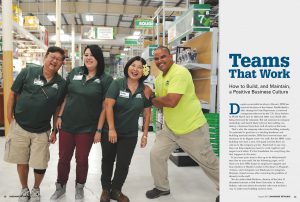Click the picture to download a PDF of this story.
By Jesse Carleton, jcarleton@nrha.org, Chad Husted, chusted@nrha.org, and Liz Lichtenberger, llichtenberger@nrha.org
Despite an enviable location in Hawaii, HPM has survived its share of hard times. Established in 1921 during the Great Depression, it survived a temporary takeover by the U.S. Navy Seabees in World War II and, in 1946 and 1960, was rebuilt after being destroyed by tsunamis. But ask someone in company leadership, and they’ll likely tell you that nothing can destroy a business faster than lack of unity on the team.
That’s why the company takes team building seriously. To maintain its position as a leading hardware and building material retailer, HPM has invested time and resources in its biggest asset—its staff. But for HPM, team building isn’t just a nice, feel-good activity that’s an add-on to the company picnic. Teamwork is any way they can help employees learn to work together and respect each other. It’s the foundation for everything else that happens in the store.
If you want your store to live up to its full potential, turn first to your staff. In this article, we’ll show you how HPM keeps its employees engaged and how retailers at HomCo Lumber & Hardware in Flagstaff, Arizona, and Livingston Ace Hardware in Livingston, Montana, found success after correcting the problem of disunity in the staff.
We also talk to Rob Mathews, director of the John H. Schnatter Institute at Ball State University in Muncie, Indiana, who has advice for retailers who want to find a way to make team building work for them.
Building a Company Culture
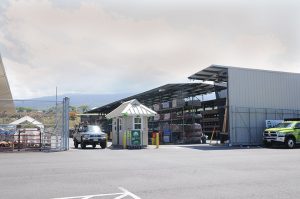
A sense of the importance of working together runs deep at HPM, which has eight retail locations as well as distribution and building material production facilities in Hawaii. The company is 100-percent employee owned, which means everyone has a vested interest in maintaining a business that runs smoothly and profitably. For Tracie White, talent development manager at the company, the purpose for team-building is simple: Employees who learn to work together are more productive. They deliver better customer service and sell more.
Team building is the culmination of a process that starts with teaching people to get along, says White. The more she gets employees engaged in team-building exercises, the more she’s able to see its effects.
Team building reduces the number of groups that don’t communicate much with each other. When they don’t communicate, or help each other out, they slow down the efficiency of the store and make it more difficult to deliver good customer service.
One of White’s roles at the store is to encourage team building whenever and wherever she can, across all of HPM’s facilities. In staff meetings, she mixes employees from different departments so they feel more comfortable talking with each other when they’re on the job. “When they start building their own networks in the company, instead of always going to management with their questions, they can go to their peers first,” she says. That helps them solve problems faster.
Employees with a team mentality are also willing to help wherever needed, even if it means working outside their job descriptions. That improves overall employee morale, which has a ripple effect everywhere in the operation. Employees will also be able to take better care of customers, because they’re working together to find answers to questions and meet needs.
By promoting a spirit of team building in your business, you are also showing you want to invest in your employees. You are demonstrating you want employees to have a great work environment, you care about their needs and prioritize making their jobs more productive. That can reduce turnover and help employees feel more invested in the company.
“Many times we, as retailers, focus first on our facilities and on the products we are selling, and tend to put the most investment on those items,” White says. “But you can’t do anything without the people and without the team. When something starts to go wrong with your business, it’s because employees are isolated from each other. Customers can feel that, and employees don’t want to stay somewhere like that. Focusing on team building will improve your business from both a morale and profitability standpoint.”
How Team Building Works at HPM

White encourages employees throughout the company to work together, both formally and informally. There’s no single best way to make it happen, but here are a few of her strategies.
Overcome the ‘Too Busy’ Excuse
Ask the typical retailer if they are promoting teamwork among their staff, and the first excuse you will hear, White says, is “I’m too busy.” “I think we as retailers understand that the more we learn to work together, the better for our customers and the better for us,” she says. “But we get so caught up in the day-to-day tasks that we forget the bigger picture of the importance of working together as a team.”
To forego time spent in simple team-building exercises is nearsighted, she says. However, getting buy-in from all of her managers and staff requires work on her part. White talks to each team leader on staff, face to face, to explain what she’s hoping to accomplish through her team-building activity and asks for their feedback. Then, she talks to individuals on the team and tells them that while she understands they have a lot to do that day, if they will just give her an hour of their time, it will be worth it in the long run. Generally, she finds employees are enthusiastic about participating; they just need their minds put at ease that pulling away for a team-building session is just as important as the list of tasks they have to do.
“You’re looking for that aha! moment when they finally understand what it means to
work together.”—Tracie White, HPM
Keep It Simple
When it comes to planning a team-building activity for the staff, don’t think you have to create elaborate exercises. Less is more. And it should be fun. The best activities are simple, and the more complicated they are, the more likely you are to run into trouble.
It’s good to have a plan, but don’t let your plan hijack the natural flow of the meeting or stifle what might start to happen naturally as your employees get together. “I always over plan the activity in my head, and then just let it go naturally,” White says. “During the activity, the real idea is for me to be quiet and just roll with it, and let the people team build.”
Activities don’t need a lot of expensive resources. White usually just gathers items from around the store. “People react a lot better when you don’t need a lot of resources,” she says. “If you make it too fancy, people will focus on the fanciness and not on the team building. You’re looking for that aha! moment when they finally understand what it means to work together.”
Determine Your Objective
If you are planning a formal team-building activity, first determine what you want to get out of it. Some activities might promote trust, while others focus more on communication. White talks to managers at each location about their teams’ strengths and weaknesses. She asks what results they would like to see from a team-building activity, and then starts planning appropriate activities from there.
For example, if it seems different teams in a particular store distrust each other, she will look for an activity centered on trust. That could involve putting a blindfold on one person and then having another lead them through an obstacle course.
Let Employees Job Shadow
One of the best ways to establish stronger teams is to make sure everyone on staff has a sense of what everyone else is doing. White wants to help each employee know as much about the company as possible, especially if they are considering transitioning into a new role in the company.
To help, employees have the opportunity to shadow someone working in their desired position and make sure they want to take on all the responsibilities that new job entails. Sometimes employees are still eager to take on the new role; other times they decide the new job is not for them. In either case, it’s a win for the employee and the company. What’s important is how the employee was able to see the company from another viewpoint.
“The best team building happens from job shadowing someone else and seeing the world from their point of view,” she says. “That builds the connection, understanding and empathy for other employees.”
Promote Activities Outside of Work
Some of the most effective team building happens outside of planned activities, and even outside of work. Finding ways to get employees to eat together, such as a pitch-in meal, is a simple but powerful way to build a team.
“The best events are those that just sprout up, those that the employees plan on their own and that happen outside of work,” White says. It might be a group going to the beach together, or a movie. “That’s when they can let their true personalities come out and get to know each other and enjoy being with each other. Get your employees to feel comfortable being together, and you’ll start to build a team.”
When promoting activities outside of normal working hours, make sure you are paying employees for any mandatory function. And make sure they don’t feel pressured to be a part of an after-work function if it’s an informal gathering where they are not getting paid.

Beware of Team Killers
As you work on building a team, be on the lookout for those attitudes that can sabotage your efforts. Ego is a primary culprit. There may be those who feel they are self-sufficient and have all the answers, so they don’t need a team. The antidote is to encourage them to see the bigger picture.
Just as harmful are the naysayers—those who are always criticizing the company, other team members or company activities. Stop negative attitudes early before they permeate the entire group, which can happen quickly.
When White hears a naysayer, she doesn’t call them out in front of the entire group. Rather, she will talk to them privately and ask them to tell her more about what is bothering them. “It could be that they just need to talk through the situation and don’t know how to express how they’re feeling about it,” she says. “I don’t put the person on the spot, as that might drive them further into their negative attitude, but I don’t ignore it, as it might influence other people.”
Model From the Top
Teams are stronger when employees realize that everyone, even the leadership, will help out when needed. HPM is a family business that dates back five generations. Michael Fujimoto is the current CEO and his son, Jason, is president. Michael’s father, Robert—Bobby—is retired but is still a visible presence at the company.
Each of those family members is never far removed from the day-to-day operations and the people who make it happen. “There are several occasions where I’ve spotted Bobby Fujimoto (now in his 90s) outside in the parking lot, picking up trash and putting away shopping carts,” says White. “During the big tool sale we recently had at the store, Jason Fujimoto stood at the front and greeted every customer who walked in the door. If your team can see their president wants to be a part of the team, that’s the biggest impact they can make.”

Starting From the Ground Up
Not every business has their team-building program figured out. No fear, we’re here to help. What happens when you realize that your team isn’t as strong, as close-knit or as steady as you would like? We talked to two retailers to see how they turned things around.
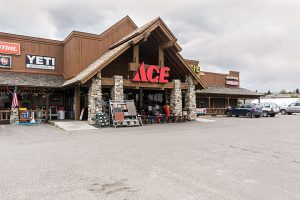
Identify the Problem
Beginning a team-building program often starts with a realization that there is a problem in the current situation. Is employee morale low? Are top employees and future management candidates leaving for other businesses rather than staying with the business? All of these signs and more can be indicators that your workforce needs a restart.
For Livingston Ace Hardware in Livingston, Montana, and its two sister stores, the call came in the form of new ownership seeing the workforce with fresh eyes. Owner Matt Dowdell and his partner Tom Shellenberg bought the group in 2006 and quickly realized that the employees felt little to no ownership in the store.
“It was really evident to me that our employees were underpaid and underappreciated. Morale and engagement were low because they didn’t have much information. They didn’t know what was happening in the business or why decisions were being made,” Dowdell says. “We wanted to demonstrate we were coming in with a different approach. We set out to better understand how we could build a business with the best pay, benefits and professional development possible in the area.”
It doesn’t always take a new owner group coming in to see that a new approach is warranted. Mike Brackin, owner of HomCo Lumber & Hardware in Flagstaff, Arizona, has been in the industry since childhood. Beginning when his father started a store called “Odds-N-Ends” in 1975, Brackin has built one of the largest lumber supply stores and retail businesses in the city.
However, the store’s growth hasn’t come without hurdles. About four years ago, Brackin and general manager Todd Callan received customer and employee engagement surveys that showed scores far lower than they had seen previously.
HomCo is different than most other hardware stores, Brackin says, as it operates as more of a lumberyard with hardware departments. The separation of the store departments led to different divisions of employees not communicating constructively, with only 5 percent of employees responding on the survey that the workforce offered good service to customers.
“When you get that response from your employees, you have a problem,” Brackin says. “We started working on our employee engagement, because that mirrors and reflects our customer engagement.”
“Employees know we are investing in them because we want them to be invested in us.”
—Todd Callan, HomCo Lumber & Hardware
Building a Foundation
Once you realize there’s a problem, the next step is determining the path to a solution. For HomCo and Livingston Ace, that meant going back to the very basics of team dynamics and employee fulfillment.
Dowdell says his and his partner’s first thought was to build a reputation around each of their stores for their positive relationship with employees. That attitude, he says, would then pay off in reactions from customers who engage with employees.
“We went line item by line item on the stores for ways to move money around,” Dowdell says. “We investigated market pay. Whatever it is, we want to be at the top. Those initial steps were all about building from the ground floor. Better benefits, better pay, more personal leave time, those are things that aren’t often seen in retail.”
HomCo also put an emphasis on developing employees and building a reputation for satisfaction in its employees. The store’s unique interview process involves a full panel of employees, from management to cashiers and floor staff, introducing job candidates to a diverse employee base. These panels show candidates that this is a place to build a career if you’re willing to buy in, he says.
“We want people to know that a career in this industry, here at HomCo, is a possibility,” Callan says. “We have 401(k) program and an aggressive paid time off program, and we put a lot of effort into our training. Employees know we are investing in them because we want them to be invested in us.”
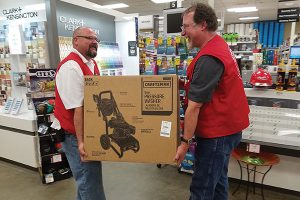
While making pay and benefits a priority can certainly help employee morale, a team culture goes beyond just numbers. Brackin, Callan and Dowdell all cite values and vision statements as the building blocks for turning around an employee base and forming a stronger unit in the workplace.
HomCo’s core values are listed as integrity, innovative thinking, maturity and judgment, people-focused behavior, accountability, communication and team leadership.
Tying each employee-to-employee interaction, as well as customer interaction, back to these vision statements and values is the beginning of remaking a culture, Callan says. For HomCo, having a busy lumberyard, along with its retail salesfloor, had developed divisions between employees that were hampering customer service. The initial stages of the new focus on values and vision statements had several hurdles, as entrenched attitudes and behaviors were still evident even as the store was gaining momentum in its team-building model.
That didn’t deter Callan’s team, he says. The end goal would be a benefit for the employees, the business and its customers, and he kept his sights on that.
“When we said, ‘This is how we’re going to move forward,’ we had a lot of fallout and turnover during about a two-year period. Total buy-in wasn’t there,” Callan says. “A lot of what we’re trying to do is get people working together. Internal customer service is the key. We’re not building walls up between the salesfloor to the lumberyard to the administration. We’re tearing those walls down.”
“The trainer has to be well-versed in everything on the floor. It might be a luxury to have a full-time trainer, but we’re putting a lot into our training.”
—Todd Callan, HomCo Lumber & Hardware
Not Just Activities
While both retailers dedicate time to activities like employee outings, communication activities and exercise programs, those aren’t the foundations of their team-building endeavors. Those things are byproducts of a solid team working together, Dowdell says, not the first step to building a team.
For Dowdell, it begins with a profile sheet asking each employee to identify which core values mean the most to them and why. It asks how interactions between employees and customers can be related back to these values and what an employee feels their role is in the culture.
HomCo maintains a full-time trainer on staff as part of its onboarding process for new hires that is an integral part of its team-building environment, Callan says. Investing in a dedicated trainer not only helps a new hire learn the necessary job-specific skills, but it also immerses the new hire in the company’s culture, attitude and dedication to its values.
Not surprisingly, the trainer position is key for HomCo’s success in team building. Staying consistent on the store’s training philosophy has helped foster the communal environment they were seeking from the beginning, Callan says.
“The position has really evolved from when we started,” Callan says. “The trainer has to be well-versed in everything on the floor. It might be a luxury to have a full-time trainer, but we’re putting a lot into our training.”
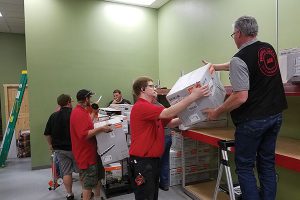
Outside Help
Contractors and team-building experts can be great resources for retailers looking to revamp their culture and team dynamics, and both Livingston Ace and HomCo looked to outside sources for help in their own efforts.
Having an outside perspective was key to identifying exactly what was causing the low engagement scores, Brackin says, but the more important benefit is the kind of crossing of ideas, methods and practices that can be difficult for a smaller retailer to achieve.
“We are in a group of other retailers who work with the same contractor, and it’s important due to one fact: You don’t know what you don’t know. Everyone thinks they’re doing the right things, but this gets you out of your own tunnel and engaging with other people working through the same issues that you are,” Brackin says.
While budgeting the cost of an outside consultant can be a daunting task, Brackin says it is more about an attitude of listening to outside ideas.
“Small retailers think they can’t get that help, but they can. Maybe not always on the same level, but there are a lot of things out there to learn. Even if resources are thin, you can determine your goals and go from there,” Brackin says.


Making a Team Successful
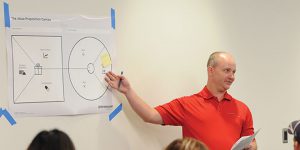 Rob Mathews
Rob Mathews
Director
John H. Schnatter Institute
Ball State University
Mathews served as assistant director of the entrepreneurship center for six years prior to becoming the director of entrepreneurial leadership at the university level. He has previously been part owner in Marco True Value Hardware in Marco Island, Florida, and owner of Mathews True Value Home Center in Pendleton, Indiana.
Hardware Retailing (HR): What’s the importance of having a good sense of teamwork among your employees?
Rob Mathews (RM): It’s definitely very important. It helps when employees are aware of each other’s quirks, abilities and preferences. They may not always agree, but they can better understand where the other is coming from.
I think sports are a good analogy. There are defined roles, as well as certain measures of accountability. Each person has a responsibility, or several. Occasionally you’ll have to step up and do something that maybe isn’t your bread and butter or part of your go-to skill set. If you’re asked to do those other things repetitively, you won’t be happy in your job. If that’s happening with multiple people, you won’t have a very good team dynamic, because you could have several unhappy people on your team.
It’s important to know where each person fits best in each team, so you can ensure you are using each employee to his or her greatest potential or make sure you have satisfied, fulfilled employees.
HR: What are some of the ways you can implement that sense of teamwork among your staff?
RM: It’s helpful to have a common goal. That should be your starting point. It includes knowing a business’ vision, values and mission statement.
The next step is to bring awareness to who everyone is on the team. What does each person bring to the table? How do they tend to operate? What they like to do? What don’t they like to do?
There’s a program called StrengthsFinder that includes an assessment to help employees identify their strongest strengths and talents. It also includes an exercise called “The Best of Me.” You ask each person to finish these sentences: “You get the best of me when …” and “You get the worst of me when …” It helps people identify how they work best in their workplace.
Next comes responsibility and accountability. Let’s go back to the sports analogy. If you put a wide receiver at quarterback for a game, you’re putting them in a role that they aren’t most comfortable with. Maybe all three of your quarterbacks are hurt and it’s what you have to do, but it’s not ideal.
HR: Do you think personality assessments play a helpful role?
RM: I’m a big fan of assessments. I tend to think of personality or temperament profiles as being like the air we breathe. Personality is always present and generally doesn’t change much.
These personality assessments, such as Myers-Briggs or DiSC, provide some great information. If you look at these results, you can see where there might be personality conflicts or where people might work exceptionally well together, and it certainly helps to be aware of those.
But you have to go beyond that. The next step is to look at functionality. You’ll be working to look at each employee’s expectations and performance.
I think the StrengthsFinder program does a good job of showing how people are wired. If you know that, you know what makes each person more engaged and more productive. With a collection of engaged employees, you have good team dynamics and good teamwork.
For example, an extroverted person could do an exceptional job on the salesfloor, but if they’re dealing with an introverted customer, there might be a problem. An introverted and deliberative employee might do a better job working with that particular customer, who will want some time to think and process things.
I think assessments often involve just the first step, the personality profile. The functionality side—what to do with this information and how it helps figure out where someone fits best on a team—is really important.
Once you know what each person’s personality is like, you have to look at how it can affect which job would be best for them. You have to get in to the psychology of what drives people, what sandbox they like to play in.
“If you know more about the people you already have, you can see where there are missing holes, and you can look to hire people with those specific skill sets.”
HR: What about team-building activities?
RM: When I think of the phrase “team building,” I think of two very different definitions. One would be to look at how you build a team as a leader or manager. The other is what most people probably think of when they hear “team-building exercise,” and that’s something like a bowling night or ropes course.
The first type would involve an exercise you might find through StrengthsFinder or DiSC. Those can be extremely helpful. People can talk about what they like and how they work best.
You can draw in some personal things, but it’s really a good way to get to know someone professionally. This helps ensure you have staff members in the right positions on the team, or if you don’t, that you can look at possibly reorganizing to ensure you have everyone in the best place possible.
It’s also helpful information to have if you’re looking to hire someone else for your team. If you know more about the people you already have, you can see where there are missing holes, and you can look to hire people with those specific skill sets.
Other team-building exercises, such as a ropes course or some sort of trust exercise, can be good, but the results are temporary. I had a mentor who told me once that you have to be careful doing these exercises after work hours, as employees may think you are getting in to their personal time and may resent that. It’s not saying you can’t do them then, but it’s something to think about.
Also keep in mind that some people might not like a particular activity. They may not enjoy bowling or may be embarrassed. If you take them too far out of their comfort zone, it can have a damaging effect. You have to make sure you pick an activity that is “safe” and that may not make anyone feel uncomfortable.
“Good communication is a very important part of having a strong sense of team among your employees.”
HR: Do you think regular meetings or group huddles are helpful?
RM: They are good if they are purposeful. If it’s a feel-good exercise, you’ll have a small percentage of employees who love it, but the rest might not. If it’s to communicate key information or ask a couple of questions or catch up quickly on a certain project, that’s fine, but don’t have a meeting without any real reason.
Otherwise, those who are most social may enjoy the meeting, but the rest are going to wonder why everyone is attending meetings that seemingly have no purpose.
It’s probably better to have meetings as needed, rather than schedule them every week or every month, unless there’s a set purpose. For example, a monthly meeting might allow everyone a time to give updates on what they are working on, but a good team is already doing that perpetually. Regular meetings may become something you’re doing because you feel it’s your duty to have them.
Now, if you’re all working on a big project and five people are participating, each with a different responsibility, then yes, it’s important to meet and make sure everyone is on pace, no one is having issues and the project is coming together as planned.
HR: What are some steps retailers can take to help instill a sense of teamwork among their employees?
RM: Retailers should know their vision, values and purpose first.
Look at these big-picture items for your business, and make sure your employees know them, too. Share your mission statement and values with your employees, too, if you haven’t already.
Next, everyone should know everyone else’s roles and responsibilities.
The different assessments allow every member of the team to learn about everyone’s personalities and working styles, and it helps ensure you have all your employees in the right positions.
It’s also a good time to do any reorganizing or talk about the possibility of moving any employees to new positions.
Then, there’s the importance of using a common language—it could be from Myers-Briggs, or DiSC, or StrengthsFinder or somewhere else—to ensure everyone is communicating well and is on the same page. Good communication is a very important part of having a strong sense of team among your employees.
You need to make sure people mesh well professionally to do their jobs well. They may not be best friends, but if they work well together, understand everyone’s roles on the team, know all responsibilities and can hold each other accountable, then you can have a good team dynamic.
 Hardware Retailing The Industry's Source for Insights and Information
Hardware Retailing The Industry's Source for Insights and Information




